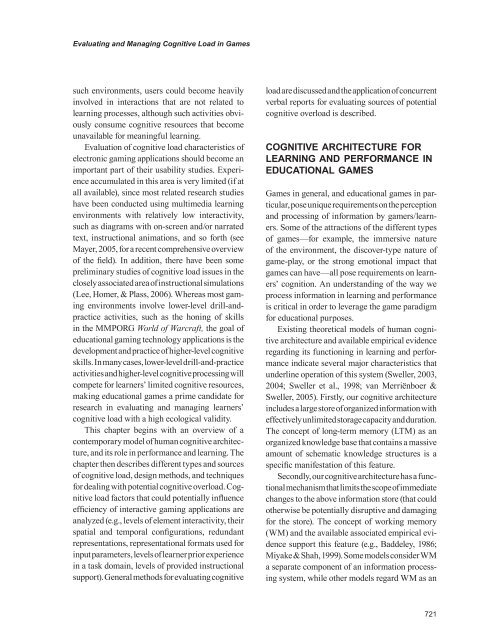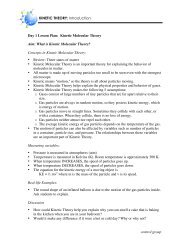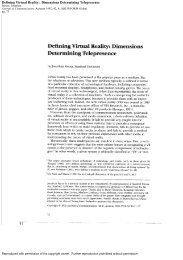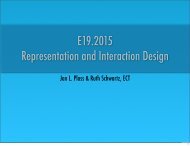Evaluating and managing cognitive load in educational games
Evaluating and managing cognitive load in educational games
Evaluating and managing cognitive load in educational games
Create successful ePaper yourself
Turn your PDF publications into a flip-book with our unique Google optimized e-Paper software.
<strong>Evaluat<strong>in</strong>g</strong> <strong>and</strong> Manag<strong>in</strong>g Cognitive Load <strong>in</strong> Games<br />
such environments, users could become heavily<br />
<strong>in</strong>volved <strong>in</strong> <strong>in</strong>teractions that are not related to<br />
learn<strong>in</strong>g processes, although such activities obviously<br />
consume <strong>cognitive</strong> resources that become<br />
unavailable for mean<strong>in</strong>gful learn<strong>in</strong>g.<br />
Evaluation of <strong>cognitive</strong> <strong>load</strong> characteristics of<br />
electronic gam<strong>in</strong>g applications should become an<br />
important part of their usability studies. Experience<br />
accumulated <strong>in</strong> this area is very limited (if at<br />
all available), s<strong>in</strong>ce most related research studies<br />
have been conducted us<strong>in</strong>g multimedia learn<strong>in</strong>g<br />
environments with relatively low <strong>in</strong>teractivity,<br />
such as diagrams with on-screen <strong>and</strong>/or narrated<br />
text, <strong>in</strong>structional animations, <strong>and</strong> so forth (see<br />
Mayer, 2005, for a recent comprehensive overview<br />
of the field). In addition, there have been some<br />
prelim<strong>in</strong>ary studies of <strong>cognitive</strong> <strong>load</strong> issues <strong>in</strong> the<br />
closely associated area of <strong>in</strong>structional simulations<br />
(Lee, Homer, & Plass, 2006). Whereas most gam<strong>in</strong>g<br />
environments <strong>in</strong>volve lower-level drill-<strong>and</strong>practice<br />
activities, such as the hon<strong>in</strong>g of skills<br />
<strong>in</strong> the MMPORG World of Warcraft, the goal of<br />
<strong>educational</strong> gam<strong>in</strong>g technology applications is the<br />
development <strong>and</strong> practice of higher-level <strong>cognitive</strong><br />
skills. In many cases, lower-level drill-<strong>and</strong>-practice<br />
activities <strong>and</strong> higher-level <strong>cognitive</strong> process<strong>in</strong>g will<br />
compete for learners’ limited <strong>cognitive</strong> resources,<br />
mak<strong>in</strong>g <strong>educational</strong> <strong>games</strong> a prime c<strong>and</strong>idate for<br />
research <strong>in</strong> evaluat<strong>in</strong>g <strong>and</strong> <strong>manag<strong>in</strong>g</strong> learners’<br />
<strong>cognitive</strong> <strong>load</strong> with a high ecological validity.<br />
This chapter beg<strong>in</strong>s with an overview of a<br />
contemporary model of human <strong>cognitive</strong> architecture,<br />
<strong>and</strong> its role <strong>in</strong> performance <strong>and</strong> learn<strong>in</strong>g. The<br />
chapter then describes different types <strong>and</strong> sources<br />
of <strong>cognitive</strong> <strong>load</strong>, design methods, <strong>and</strong> techniques<br />
for deal<strong>in</strong>g with potential <strong>cognitive</strong> over<strong>load</strong>. Cognitive<br />
<strong>load</strong> factors that could potentially <strong>in</strong>fluence<br />
efficiency of <strong>in</strong>teractive gam<strong>in</strong>g applications are<br />
analyzed (e.g., levels of element <strong>in</strong>teractivity, their<br />
spatial <strong>and</strong> temporal configurations, redundant<br />
representations, representational formats used for<br />
<strong>in</strong>put parameters, levels of learner prior experience<br />
<strong>in</strong> a task doma<strong>in</strong>, levels of provided <strong>in</strong>structional<br />
support). General methods for evaluat<strong>in</strong>g <strong>cognitive</strong><br />
<strong>load</strong> are discussed <strong>and</strong> the application of concurrent<br />
verbal reports for evaluat<strong>in</strong>g sources of potential<br />
<strong>cognitive</strong> over<strong>load</strong> is described.<br />
cOGNItIVE ArcHItEctUrE FOr<br />
LEArNING AND PErFOrMANcE IN<br />
EDUcAtIONAL GAMEs<br />
Games <strong>in</strong> general, <strong>and</strong> <strong>educational</strong> <strong>games</strong> <strong>in</strong> particular,<br />
pose unique requirements on the perception<br />
<strong>and</strong> process<strong>in</strong>g of <strong>in</strong>formation by gamers/learners.<br />
Some of the attractions of the different types<br />
of <strong>games</strong>—for example, the immersive nature<br />
of the environment, the discover-type nature of<br />
game-play, or the strong emotional impact that<br />
<strong>games</strong> can have—all pose requirements on learners’<br />
cognition. An underst<strong>and</strong><strong>in</strong>g of the way we<br />
process <strong>in</strong>formation <strong>in</strong> learn<strong>in</strong>g <strong>and</strong> performance<br />
is critical <strong>in</strong> order to leverage the game paradigm<br />
for <strong>educational</strong> purposes.<br />
Exist<strong>in</strong>g theoretical models of human <strong>cognitive</strong><br />
architecture <strong>and</strong> available empirical evidence<br />
regard<strong>in</strong>g its function<strong>in</strong>g <strong>in</strong> learn<strong>in</strong>g <strong>and</strong> performance<br />
<strong>in</strong>dicate several major characteristics that<br />
underl<strong>in</strong>e operation of this system (Sweller, 2003,<br />
2004; Sweller et al., 1998; van Merriënboer &<br />
Sweller, 2005). Firstly, our <strong>cognitive</strong> architecture<br />
<strong>in</strong>cludes a large store of organized <strong>in</strong>formation with<br />
effectively unlimited storage capacity <strong>and</strong> duration.<br />
The concept of long-term memory (LTM) as an<br />
organized knowledge base that conta<strong>in</strong>s a massive<br />
amount of schematic knowledge structures is a<br />
specific manifestation of this feature.<br />
Secondly, our <strong>cognitive</strong> architecture has a functional<br />
mechanism that limits the scope of immediate<br />
changes to the above <strong>in</strong>formation store (that could<br />
otherwise be potentially disruptive <strong>and</strong> damag<strong>in</strong>g<br />
for the store). The concept of work<strong>in</strong>g memory<br />
(WM) <strong>and</strong> the available associated empirical evidence<br />
support this feature (e.g., Baddeley, 1986;<br />
Miyake & Shah, 1999). Some models consider WM<br />
a separate component of an <strong>in</strong>formation process<strong>in</strong>g<br />
system, while other models regard WM as an<br />
721








